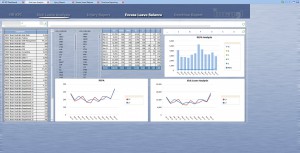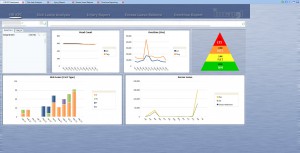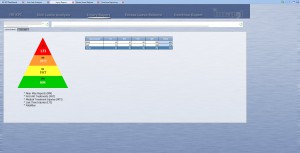Business Intelligence and Corporate Performance Management can be an invaluable tool in assessing business trends, giving CEOs and CFOs critical information at the right time to make well informed strategic decisions. Until recently, BI was mainly used for financial reporting and analysis and rightly so, since finance is probably given the top priority in most businesses.
However, off late Business Intelligence is being used in many other areas of businesses including HRM. HRM involves a complex array of data with monitoring total headcount, overtime hours, leave management, performance appraisals, KPIs, compensations and much more. BI comes in very handy right from the hiring process to the “letting go” process.
Hiring Prospective Employees
The same indicators used to measure business performance or consumer buying patterns can also be used to measure the “employee fit” to a specific role. Most HR managers have a list of qualities they look for in a prospective employee. And then the interviews provide the platforms for data collection. Some of these qualities could be in the form of product knowledge, leadership skills, interpersonal skills, average time spent on social media, humility, attitude and much more. Decision on hiring the best fit candidate largely depends on the HR managers “perception” of the data analysis, except it is gut feel and not really data analysis.
Business Intelligence can be smartly implemented to provide analytical information helping HR managers make a well informed evidence based decision.
For example, a candidate’s time spent on Facebook and other social media platforms could either be a strength or a weakness depending on the role the candidate is being considered for. Many a times there are preconceived notions that arise from simply reading through a candidate’s resume. The resume may reveal that the candidate has changed jobs very frequently and this could easily be interpreted as a sign of bad workplace practices. However in reality, it could have been external economic factors, personal family reasons which were only temporary in nature or even a lack of adequate demand for the individual’s unique skill set. Maybe the candidate is a perfect fit for the current role. Likewise with various other attributes of a potential candidate.
A good BI tool can help analyse these attributes, compare various candidates on all required qualities for the role and present you with the most likely fit right down to the least likely fit. In most cases, it is very easy to identify the least likely fit. The most likely fit might not come cheap. The challenge is in choosing the “right” individual at the right cost for the right role. These candidates appear somewhere in the middle to high range of a bar graph. This is where a BI solution can come in handy in making a well informed decision.
Retaining Current Employees
There are very clever BI tools available these days. Some of them even learn about an organisation and its employees over time and present you with possible predictions. There is usually a complex web of information that goes into managing a healthy HR in an organisation. These include the hiring process, salaries, performance appraisals, KPIs, staff retentions, promotions, relocations, estimated cost of living, firing and much more.
A cleverly implemented business intelligence solution can analyse all of the above information on an ongoing basis, determine the level of employee satisfaction and potentially even predict the longevity of certain staff members within the organisation.
Analysing performance appraisals and staff KPIs can reveal the “skill to role” fit for individuals and determine the most productive individuals as opposed to the least productive. This helps take corrective measures at the right time saving valuable time and costs for the organisation.
It has been observed that an organisation performs best when all employees actually “own” their respective roles and work together like a well-oiled machine, depending on each other. A good example would be an orchestra. For an orchestra to produce an amazing piece of music, all the various musicians would need to know the whole musical piece and yet only play their respective roles, just in time. Ignorance of the whole piece by any one musician (though the individual part is well rehearsed) can potentially ruin the entire performance.
Likewise an organisation runs best when all employees are made aware of the big picture on an ongoing basis irrespective of their individual roles. Allowing employees access to a generic performance dashboard with respect to their organisational progress or even their own departmental progress in the face of revenue goals, strategic objectives and policies can be very motivating. The non-management staff feel very much part of the strategic discussions and gain a whole new respect for the business. They begin to realise their roles in the big picture and “own” their responsibility leading to a significant increase in productivity.
Compensation Analysis
When dealing with compensation and pay rises, most managers rely on very basic information such as a certain “average percentage” across the board. In some cases, employee commitment levels and skill levels are taken into consideration. Rarely do managers rely on more advanced statistics that allow them to visualise the impact of their compensation decisions.
Using a business intelligence tool can help deliver greater insight of potential business impact to HR managers and CFOs. Additionally, evaluating performance vs rewards could potentially keep the organisation from losing some of its most valuable staff members to competition.
A smartly implemented BI solution will allow you to foresee a “what if” scenario. This means, it would allow the HR manager to propose salary changes and actually see the business impact from a financial point of view in comparison to forecasted future revenue. A salary revision combined with an analysis of performance reviews and/or KPIs can immensely help HR managers reward the right individuals and retain top talent.
Leave Analysis
This is another complicated area in a HR department which can be made quite easy with a business intelligence tool. I have come across organisations that have staff members that are part timers working different number of hours each week and on different days. This can be further complicated if the part timers do not have a standard week. Reporting on paid leave, unpaid leave, maternity leave, bereavement leave, etc can be quite frustrating.
In addition, very rarely do organisations actually analyse the leave impact on businesses. In many cases, there are just a few employees on whom the organisation desperately depends on and when they go on leave, nothing functions. This ought not to be.
A good business intelligence tool can help you avoid such scenarios and more importantly analyse the leave impact on businesses. Valuable analyses on staff leave and its impact on the business can assist hugely in planning staff leave with minimal business interruption.
In addition, the BI tool can assist you with comparisons on targeted overtime hours vs actual overtime hours, sick leave allowed vs taken and much more. Here a few examples:
Health and Safety Regulations
If you are in New Zealand, (and probably in many other countries) health and safety is a big issue for most organisations. There are far too many details to be aware of and it is even harder to ensure all staff members are adhering to the health and safety regulations as required by law. It is necessary to record all incidents along with preventive measures taken. Failure to adhere to health and safety regulations can potentially cause serious losses in the form of fines and other payments to the authorities.
A good business intelligence tool can help create workflows to ensure health and safety regulations are met, monitor the incidents, preventive measures, level of safety in each department and so on. This could reveal departments or areas of businesses with the most number of incidents and help you prioritise accordingly.
In my opinion, Business Intelligence is a tool both small and large organisations alike need to invest in as a necessary asset. Consider a visit to your doctor. Most doctors usually have a set of standard tests. The results of these tests help them diagnose your health condition and prescribe the right medication. You wouldn’t leave them to treat you based on “gut feel”, would you? So also, a Business Intelligence tool is your diagnostic lab for your business.
Santosh Chandran is the Business Development Manager for BOARD Management Intelligence at Olympic Software. He regularly blogs about business intelligence and corporate performance management. You can follow him on Twitter or on LinkedIn. Please contact him directly if you would like to find out how BOARD can improve your business results through better decision making, phone +649 980 3964 or email: santoshc@olympic.co.nz





